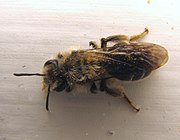
Erythronium propullans, the Minnesota dwarf trout lily, Minnesota adder's tongue or Minnesota fawnlily, is a rare plant endemic to the Cannon River and North Fork Zumbro River watersheds in Rice County, Goodhue County and the extreme northern edge of Steele County, Minnesota, in the United States. The plants are believed to be a mutation or sport of the white trout lily and evolved following the most recent ice age.

Andrena is a genus of bees in the family Andrenidae. With over 1,500 species, it is one of the largest genera of animals. It is a strongly monophyletic group that is difficult to split into more manageable divisions; currently, Andrena is organized into 104 subgenera. It is nearly worldwide in distribution, with the notable exceptions of Oceania and South America. Bees in this genus are commonly known as mining bees due to their ground-nesting lifestyle.

Anemone hepatica, the common hepatica, liverwort, kidneywort, or pennywort, is a species of flowering plant in the buttercup family Ranunculaceae, native to woodland in temperate regions of the Northern Hemisphere. This herbaceous perennial grows from a rhizome.

The tawny mining bee, Andrena fulva, is a European species of the sand bee (Andrena) genus. The males are 10–12 mm (0.4–0.5 in) and the females 8–10 mm (0.3–0.4 in) long. The female is covered with fox-red hair on the dorsal surface of its thorax and abdomen and black hair on its head and ventral surface. The male is less distinctive, being clad in golden-brown or reddish-brown hairs, with some long white hairs on the face, and a tooth on each of the mandibles.
Andrena salicifloris, or the willow flower miner bee, is a miner bee in the genus Andrena. Another common name for this species is the willow mining bee. The bee ranges from Colorado to California and north to British Columbia, and often inhabits arid and alpine lands. The bee is often black or dark brown, and is sparsely coated with grayish hair on the thorax, legs and on the abdomen. The pollen basket is on most of the hind leg. The wings of the willow flower miner bee are smokey, and their veins are black.

Andrena marginata, sometimes called the small scabious mining bee is a species of the sand bee (Andrena) genus.

Andrena agilissima is a species of mining bee. They are present in most of Europe, the Near East and North Africa and can be found from April through July. Andrena agilissima is an oligolectic species, feeding only on the pollen of a few genera of Cruciferous vegetables.

Andrena scotica, the chocolate mining bee or hawthorn bee, is a species of mining bee from the family Andrenidae. It occurs in western Europe and is one of the most frequently encountered mining bees found in Great Britain, where it had been previously misidentified as Andrena carantonica.

Nomada marshamella, Marsham's nomad bee, is a species of Palearctic cuckoo bee which appears to be a wasp mimic and which is cleptoparasite on the mining bees of the genus Andrena, especially A. scotica and A. trimmerana.

Andrena aliciae, the yellow-faced miner bee, is a species of miner bee in the family Andrenidae. It is native to North America.
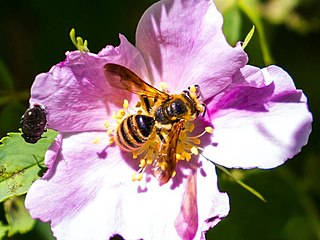
The golden-haired miner bee is a species of miner bee in the family Andrenidae. The female bees are 8 to 10 mm in length, and males are 6 to 9 mm long. It is found in the western United States, and is relatively rare outside California. It looks very similar to the death camas miner bee but is smaller.
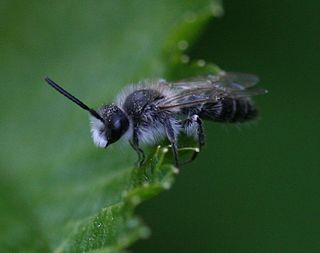
Andrena barbilabris, the bearded miner bee, is a species of miner bee in the family Andrenidae. It is found in Europe and Northern Asia and North America.

Andrena wilkella, also known as Wilke's mining bee, is a species of miner bee in the family Andrenidae. Its original distribution is Europe. It has been accidentally introduced to North America long ago, possibly with ship ballast. It is active between April and August. Andrena wilkella has been recorded to nest both singly and in aggregations. Andrena wilkella preferentially collects pollen from Fabaceae including clover and sweet clover.
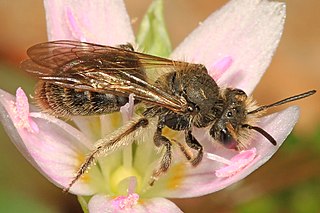
Andrena erigeniae, the spring beauty miner bee or spring beauty andrena is a species of miner bee native to North America.
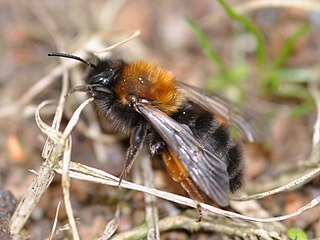
The Clark's miner bee is a species of miner bee in the family Andrenidae. Other common names include Clark's andrena and Clarke's mining bee. It is found in Europe and Northern Asia and North America.

Andrena prunorum, otherwise known as the purple miner bee, is a species of solitary bees in the family Andrenidae. It is commonly found in the continental United States as well as much of North and Central America. Andrena prunorum is a spring-flying, ground-nesting bee that serves as a ubiquitous generalist in ecological settings. Both males and females live as prepupae in the winter in which they mate, and the females seek new sites for ground burrows. From there, they construct small cells surrounding a ball of pollen combined with nectar to nourish a laid egg before each cell is sealed, and the cycle begins anew. A. prunorum generally prefer the pollen derived from Rosaceae plants but will pollinate fruit trees if given the opportunity.

Andrena bicolor, or Gwynne's mining bee, is a common and widespread Western Palearctic mining bee which is found over most of Europe as well as North Africa and the Middle East and which reaches eastwards into Siberia.

Andrena helvola , the coppice mining bee, is a Palearctic species of mining bee from the genus Andrena.
The narrow-legged miner bee is a species of miner bee in the family Andrenidae. It is found in North America. It is a generalist forager that nonetheless exhibits a preference for pollen of flowers from the Apiaceae family.
The ceanothus flower miner bee is a species of miner bee in the family Andrenidae. It is found in North America.

